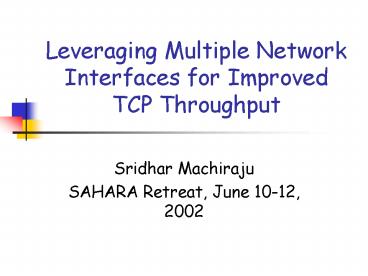Leveraging Multiple Network Interfaces for Improved TCP Throughput - PowerPoint PPT Presentation
1 / 18
Title:
Leveraging Multiple Network Interfaces for Improved TCP Throughput
Description:
Prevents TCP from reacting to duplicate ACKs due to reordering ... Another possibility buffer ACKs and eliminate unnecessary duplicates ... – PowerPoint PPT presentation
Number of Views:27
Avg rating:3.0/5.0
Title: Leveraging Multiple Network Interfaces for Improved TCP Throughput
1
Leveraging Multiple Network Interfaces for
Improved TCP Throughput
- Sridhar Machiraju
- SAHARA Retreat, June 10-12, 2002
2
Motivation
- Proliferation of Wireless LANs, rollout of 3G and
availability of devices with multiple network
interfaces (MNIs) - Can endhosts leverage multiple network interfaces
for - improved throughput (current focus)
- masking packet losses
- improving connectivity
3
Contents
- What should u expect from this presentation?
- why TCP cannot take advantage of MNIs easily
- two simple routing policies (at end-hosts) that
improve TCP throughput - Work started recently feedback appreciated
greatly
4
Problem Statement
N3
2 Mbps, 50ms
2 Mbps, 50ms
(Sender) N1
N2 (Receiver)
5 Mbps, 50ms
5 Mbps, 100ms
N4
- FTP Source N1 has 2 NIs
- The 2 paths to N2 are using N3 (2Mbps, 100ms) and
N4 (5Mbps, 150ms) - Can N1 obtain a throughput of 7Mbps?
5
A Simple RR Scheme
- Assume that the ratio of bottlenecks on both
paths is known (25 in the example) - Route 2 of every 7 packets through N3 and the
rest through N4 - Future Work Deduce the above ratio dynamically
6
Why it fails
Different RTTs on paths Packet reordering Duplicat
e ACKs False congestion signals
Throughput
Time
7
Increase DupACK threshold
- Prevents TCP from reacting to duplicate ACKs due
to reordering - But, dupACKs due to losses are also neglected
Throughput
Time
8
Discussion
- Packet reordering is inevitable
- A solution buffer packets at receiver IP layer
Chebrolu et al., UCSD - Another possibility buffer ACKs and eliminate
unnecessary duplicates - Our solution use multiple routes to the source
to send ACKs
9
DupACK routing policy
RP1
FP1
(Sender) N1
N2 (Receiver)
If DupACK, route through RP1 else use RP2
FP2
RP2
- Assume 2 paths are (delayFP1 lt delayFP2) such
that (delayFP2delayRP1) lt (delayFP1delayRP2)
(delay property) - DupACKs received only after subsequent ACKs and
are discarded
10
Example
(Sender) N1
N2(Receiver)
p2
p1
- 2 Packets p1 and p2 sent one after another on
different paths
11
Example
(Sender) N1
N2(Receiver)
p2
p1
- p2 reaches before p1 since its forward path is
shorter
12
Example
(Sender) N1
N2(Receiver)
p1
ACK1
DupACK
- p2 generates a DupACK even though p1 is not
dropped
13
Example
ACK3
(Sender) N1
N2(Receiver)
ACK1
DupACK
- p1 would generate an ACK indicating receipt of p1
and p2
14
Example
ACK3
(Sender) N1
N2(Receiver)
ACK1
DupACK is discarded
- (delayFP2delayRP1) lt (delayFP1delayRP2) implies
that the duplicate ACK is received later and
discarded
15
Discussion
- Single TCP flow is able to obtain better
throughput 7 Mbps
Throughput
Time
- Cons
- 2 paths need to obey the delay property
- slower increase of congestion window
- Pros
- better throughput
- simple policy
- packets not buffered or dropped
16
ACK Routing Policy
P1
(Sender) N1
N2 (Receiver)
Route ACKs through P1
P2
- What if DupACK policy cannot be used?
- Throughput can still be improved if
- delay(RP1) lt delay(RP2)
- capacity (RP1) gt ACK traffic
- Use high capacity path (P2) for data low delay
path (P1) for ACKs
17
Discussion
- Among competing TCP flows, flows with smaller RTT
fare better - Using our policy, RTT can be reduced
Throughput
Time
Time
Competing TCP Multipath TCP
18
Future Work
- Investigate the effect of competing TCP flows on
such policies - Devise more mechanisms esp. for other transport
protocols - Infer path properties dynamically
- Investigate approaches to deployment
- receiver side modification
- use mobility servers such as home agents
- Finally, implement these































